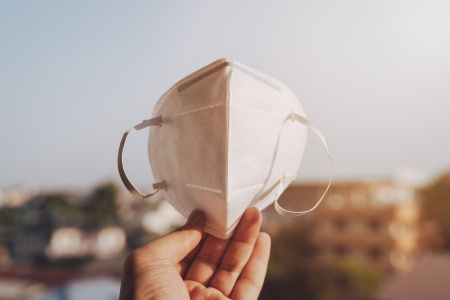In Covid-19, a large population does not show symptoms. Therefore, the asymptomatic can continue to spread the infection at home, at a faster pace.
The head of India’s Covid-19 task force, Dr V K Paul, has said the time has come to wear masks at home settings to break the chain of transmission. His recommendation comes as India reported a record 352,991 new cases on Monday and 2,812 deaths in the last 24 hours; the country’s active caseload has now reached 2,813,658.
What is the reason for this recommendation?
Covid-19 spreads primarily from person to person through respiratory droplets, which travel in the air when someone coughs, sneezes, talks, shout or sings. These droplets can then land in the mouths or noses of people in the vicinity, or may be breathed in.
Again, a large population does not show symptoms. The asymptomatic people can continue to spread the infection at home, at a faster pace. Dr Paul stressed that even when asymptomatic people are talking, they can spread the infection.
That is why we have been seeing entire families, in this wave, turning positive, even when most of them have stayed indoors.
But why during the second wave?
A significant proportion of the vulnerable population in India have been showing severe symptoms including shortness of breath, and many have required hospitalisation. The surge in the requirement of oxygen beds has overwhelmed the health infrastructure.
Masks are mainly intended to protect others from Covid-19 rather than just the wearer. Therefore, the recommendation is aimed not just at breaking the chain of transmission, but also at protecting those at highest risk.
There are two targeted outcomes. First, the elderly and those with co-morbidities can be protected significantly, even if one member of the family has an asymptomatic infection. Second, it can reduce the local house outbreaks that have marked the second wave.
Read more:NPS Vs Atal Pension Yojana: Check Benefits, Eligibility Criteria, Other Details
Did the government cite any evidence while making these arguments?
Yes, it cited data from the North Carolina Department of Health and Human Service to say that there is a negligible risk of transmission when there is a distance of 6 feet between two persons and when both of them are wearing masks.
According to the data cited, the risk is 1.5% (low) when both people are wearing masks, 5% (medium) when only the infected person is wearing a mask and uninfected persons are unmasked, 30% (high) if the infected person is not wearing a mask but the uninfected person is wearing one, and 90% (highest) when neither the infected nor the uninfected person is wearing a mask.
Have any other countries made a similar recommendation yet?
The US Centers for Disease Control and Protection (CDC) makes an almost similar recommendation. The CDC says masks should still be worn in addition to staying at least 6 feet apart, especially when indoors around people who don’t live in your household.
The CDC stresses that older people, specifically, should wear a mask when around people who don’t live in their household. Which effectively means that if a new person comes home, the vulnerable need to wear a mask to reduce the risk of getting infected.
Read more:Mental health key to surviving Covid fear, say psychologists
Apart from what the government has cited, has any other study shown the benefits of indoor masking?
Yes. A study of Chinese families in Beijing, accepted for publication in the British Medical Journal, has found that indoor masking it is 79% effective in curbing transmission — but only before symptoms emerge.
The study of 335 people in 124 families found that the risk of household transmission was 18 times higher with frequent daily close contact with the primary case; face mask use by the primary case and family contacts before the primary case developed symptoms was 79% effective in reducing transmission; however, wearing a mask after illness onset of the primary case was not significantly protective.
“The findings inform universal face mask use and social distancing, not just in public spaces, but inside the household with members at risk of getting infected. This further supports universal face mask use, and also provides guidance on risk reduction for families living with someone in quarantine or isolation, and families of health workers, who may face ongoing risk,” the authors write.



































